Milk and testosterone medically reviewed by Dr. Zac Hyde M.D)
Does Dairy Suppress Male Hormone Production?
Milk is a perfectly fine food for the average person who wants to enjoy it under the right circumstances.
Unfortunately, that might not always be the case for men interested in optimizing hormones if you’re not flexible on the type of milk you drink.
Despite its excellent nutritional status…
And the fact that milk has sustained human life through various food shortages, dairy has received a fair share of criticism over the years.
The question is, are the critics right?
Does milk have unfavorable effects on hormone levels?
I’m going answer this question right now for those of you who are not interested in reading the entire article below.
I’ll start with this…
Milk does contain estrogen and progesterone, but very little of it passes through your digestive system intact, which minimizes the negative impact.
You can reduce the impact further by drinking low fat milk products because hormones are fat soluble, so the lower the fat, the less you’ll absorb.
This explains the study mentioned below that found sperm concentrations went up with low fat milk consumption, and down with full fat consumption.
It also partially explains the results of another study discussed below…
Where men who consumed fat free milk gained significantly more muscle than subjects who consumed a carbohydrate drink or a soy protein drink.
Low fat milk is also an outstanding food for men suffering from age related muscle loss, which we’ll get into in a moment.
Milk and Testosterone (My Strategy)
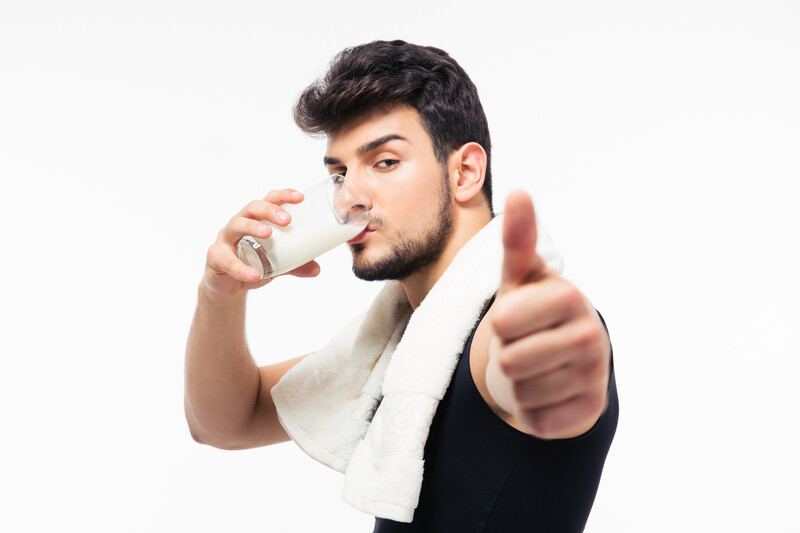
After going back and forth with milk for several years I’ve added it back into my diet successfully by doing the following.
- I only drink low fat milk to reduce the hormonal impact
- I tested several brands until I found one I tolerated well (Strauss Organic 2%)
- I culture my milk into yogurt
You can read about by culturing process at the bottom of this page.
By following these three steps, I’ve gained all the anabolic benefits of milk consumption, with none of the negatives.
So my suggestion is…
If you’re a fan of milk switch to a low fat variety and test several brands until you find one that works for you.
I tried several and it wasn’t until I purchased Strauss and fermented it that I didn’t experience bloating, puffiness and other symptoms.
I’m now able to eat up to two pints of yogurt after my muscle building routines and I’ve definitely noticed the impact on muscle growth and protein synthesis.
So if you’re interested in building more muscle, which all men should be, I suggest you test out the suggestions mentioned above.
One final thing before we get to the details…
If you find you can’t tolerate dairy after testing these protocols, you can gain the same benefits and many more by using eggs as your primary anabolic fuel.
As if you’re a lucky man and happen to tolerate both, you’re in for a big anabolic surprise.
Especially if you’ve been under eating protein or have been consuming low quality sources from grains, vegetable isolates or (gasp) soy.
Because once you add these two high quality proteins into your formerly deficient diet, the anabolic impact will be blatant.
Now here’s part 2…
Milk and Testosterone (Nutrition)
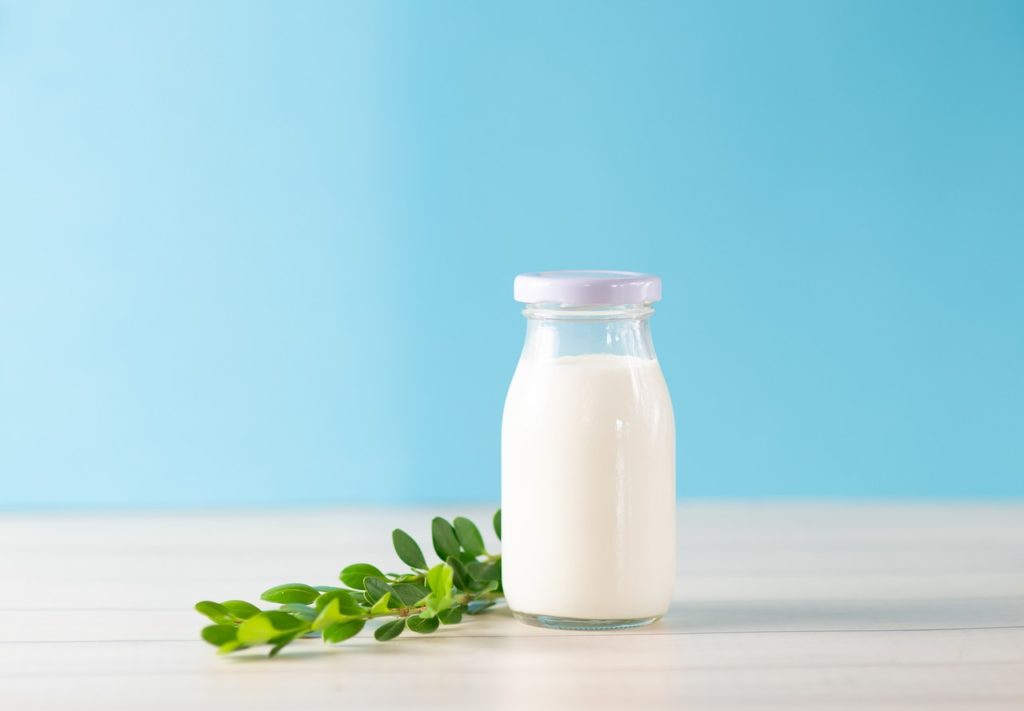
First, Some Good News: Milk’s Nutritional Profile.
Regardless of how you see milk, it has an excellent nutritional profile and is more than capable of supporting our health and physical development.
Whole milk is an excellent source of calories, protein, carbohydrates, and fats. It also includes essential micronutrients your body needs to stay healthy.
Some of these include vitamins A, B1, B2, B3, and D, calcium, phosphorus, and magnesium.
At first glance, milk is the perfect food for supporting your health and physical development.
In fact, many bodybuilders drink milk to get extra calories and nutrients to support their growth and weight gain.
Unfortunately, nutrition and foods’ impact on our health and hormones run deeper than what we sometimes see on the surface. Milk might seem like the perfect food, but there is more to consider.
Does Milk Contain Estrogen?
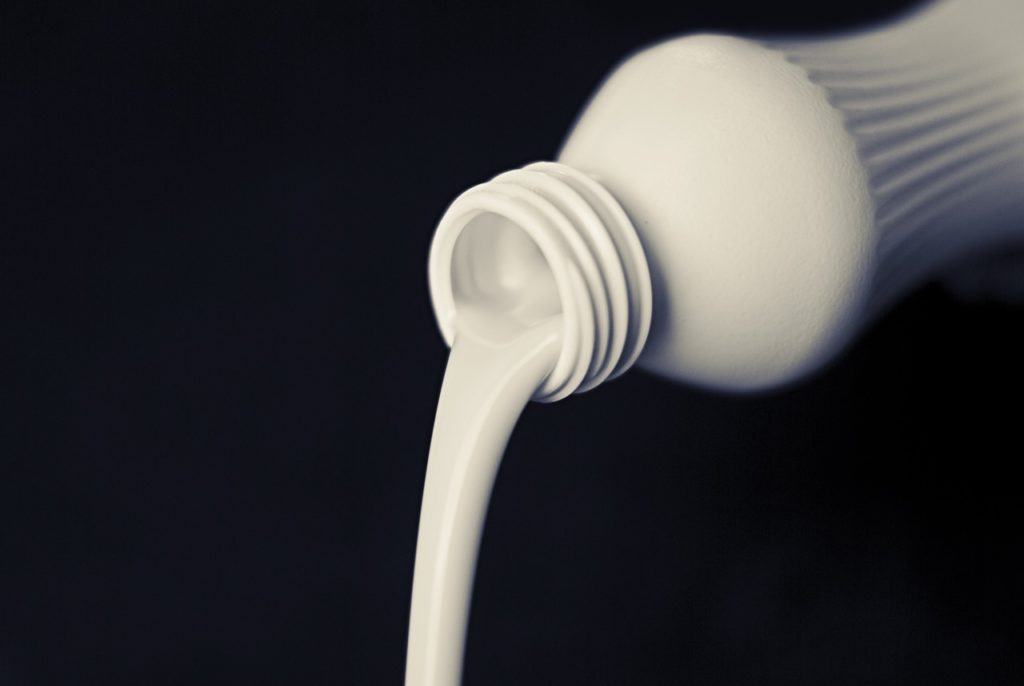
Here’s a simple law of nature no industrial human complex can change:
Cow milk is intended for baby cows. It needs to support the growth and development of cows, which have a different physiology from humans.
One notable disadvantage of cow’s milk for human consumption is that it is loaded with mammalian estrogen and progesterone.
To understand why that is the case, we must backtrack and get familiar with dairy cows and how they live.
There is a common misconception that cows lactate (produce milk) throughout their adult life, which isn’t the case.
Cows are mammals that, similar to women, begin to lactate near the end of their pregnancy and after giving birth. It all ties in with what we stated above: cow milk is intended for baby cows.
Farmers inseminate their cows to keep them pregnant for around 280-290 days per year.
They aim to keep the animal lactating for longer and produce more milk. Unfortunately, the approach carries some issues.
- It’s not the most humane way to treat cows.
- The modern dairy cow lactates through almost the entire pregnancy. As a result, the milk is heavily loaded with the female hormones estrogen and progesterone.
- These effects become magnified in cows that have been pregnant for a long time. In other words, the more times a cow has been pregnant, the more estrogen will be present in her milk.
Female Hormones in Factory Farmed Dairy
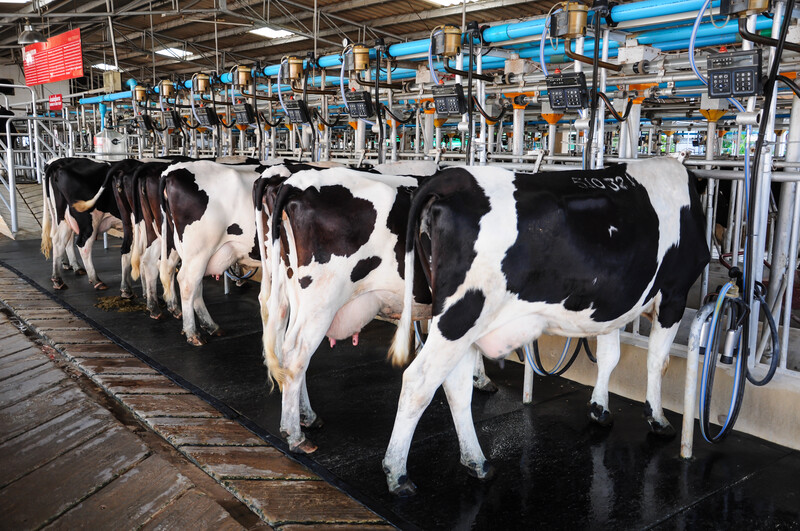
The question is, does milk contain enough estrogen to have a measurable impact on men’s health and hormone balance?
To answer the question, we have to get an idea of what we are dealing with.
Researchers measured the difference between estrogen in the milk of pregnant cows and cows that have already given birth.
According to their findings, milk from pregnant cows has up to 33 times more estrogen.
It’s difficult to say how big of an impact estrogen would have because numerous factors play a role in the equation.
Some include:
- How much milk do you consume?
- How often do you drink milk?
- What is your overall diet like?
- Are you physically active?
Still, you might be at risk of adverse effects:
Milk and Testosterone & Other Hormones
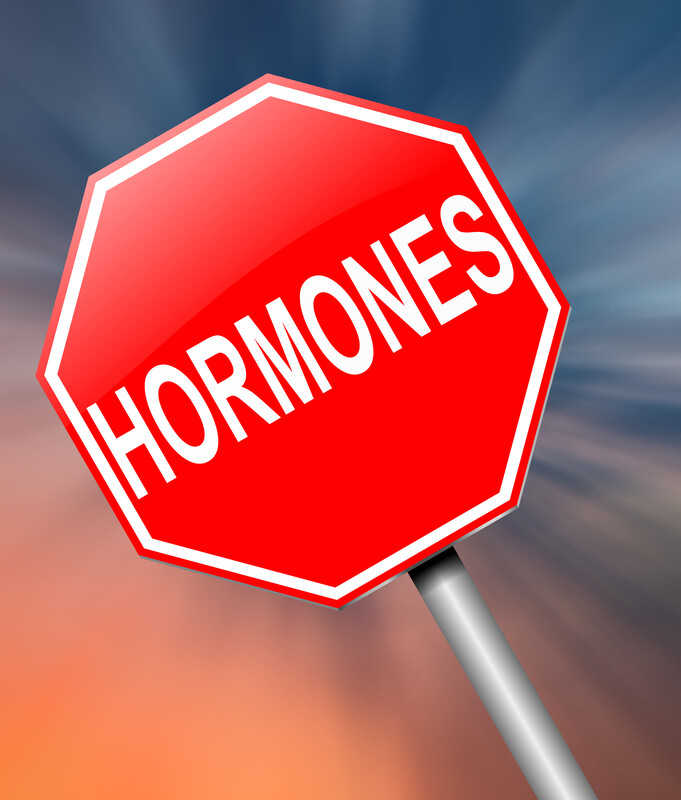
Aside from estrogen, cow’s milk is home to approximately 60 other hormones, including various estrogens and metabolites.
One hormone found in cow’s milk is progesterone. The hormone plays a huge role during pregnancy and menstrual cycle regulation.
Your adrenal glands produce small amounts of progesterone, and the hormone is necessary for some critical functions like spermatogenesis.
Unfortunately, getting progesterone from external sources can increase estrogen levels in men, resulting in depression, gynecomastia, impaired sexual function, and more.
Cow’s milk also contains some testosterone, which is good news. Sadly, the amount is not that high and unlikely to positively impact your hormone levels.
Interestingly, data suggests that drinking pregnant cows’ milk accounts for roughly 70 percent of a person’s estrogen exposure.
So, Where Are We With Hormones in Milk?
If you’ve read everything, you’re probably ready to pour your milk into the sink and permanently ban it from your diet. After all, milk is a literal hormone bomb with untold effects on your body.
Interestingly, the whole situation might be a bit more complex than that. There are numerous factors to consider, and studies show mixed results on the topic.
Let’s start with a Japanese study published in 2010. The participants were seven men, six prepubescent children, and five women.
The men and children drank 600 ml of milk, and the women drank 500 ml nightly for three weeks.
Following milk consumption, serum estrone (a minor female sex hormone) and progesterone concentrations increased significantly.
What’s worse is that serum luteinizing hormone and testosterone levels dropped. In men, luteinizing hormone is necessary for stimulating testosterone production in the testes.
Another likely explanation for the testosterone drop could be the suppressed GnRH secretion from drinking milk.
GnRH is a critical hormonal regulator of the reproductive axis and is crucial in stimulating luteinizing hormone secretion.
A 2012 study examining milk’s potential carcinogenic (cancer-causing) properties had different findings.
Estrogens have been suggested to increase cancer risk in hormone-responsive areas of the body, including the ovaries and prostate.
Since cow’s milk contains estrogens, some researchers have speculated that it could increase cancer risk.
The idea makes sense but fails because it doesn’t account for the body’s ability to regulate estradiol levels.
Further, the authors suggest that estradiol from dairy products is largely inactive in the GI tract. Only about 5 percent of it survives passing through the liver the first time.
In other words, the majority of active hormones get metabolized before they get the chance to enter the bloodstream.
Milk And Sperm Quality In Men
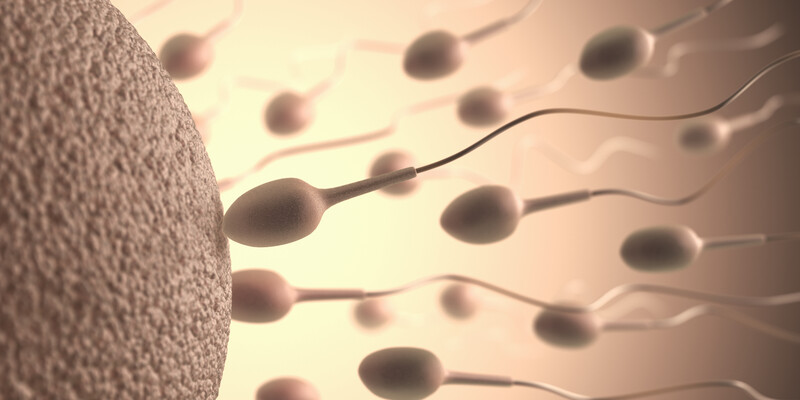
Low T levels are often associated with lower sperm production and infertility. So, given the context of today’s article, what impact would milk consumption have on ejaculations and sperm production?
In one paper, high-fat dairy intake was associated with lower sperm concentrations in past and current smokers.
The same study points out that low-fat milk consumption is related to higher sperm concentrations and motility.
Another study has similar findings. In it, researchers analyzed the nutritional habits of young men (aged 18 to 22).
There was a strong correlation between total dairy intake and lower sperm quality. According to the authors, full-fat dairy products appear to be more detrimental.
But why is that?
The hormones present in milk are fat-soluble: they “like” lipids and readily bind to them.
So, the more fat a dairy product has, the greater its capacity for carrying sex hormones like estrogen, progesterone, and testosterone.
Skim milk naturally contains smaller amounts of hormones because there aren’t as many lipids molecules.
Milk Fat and Testosterone
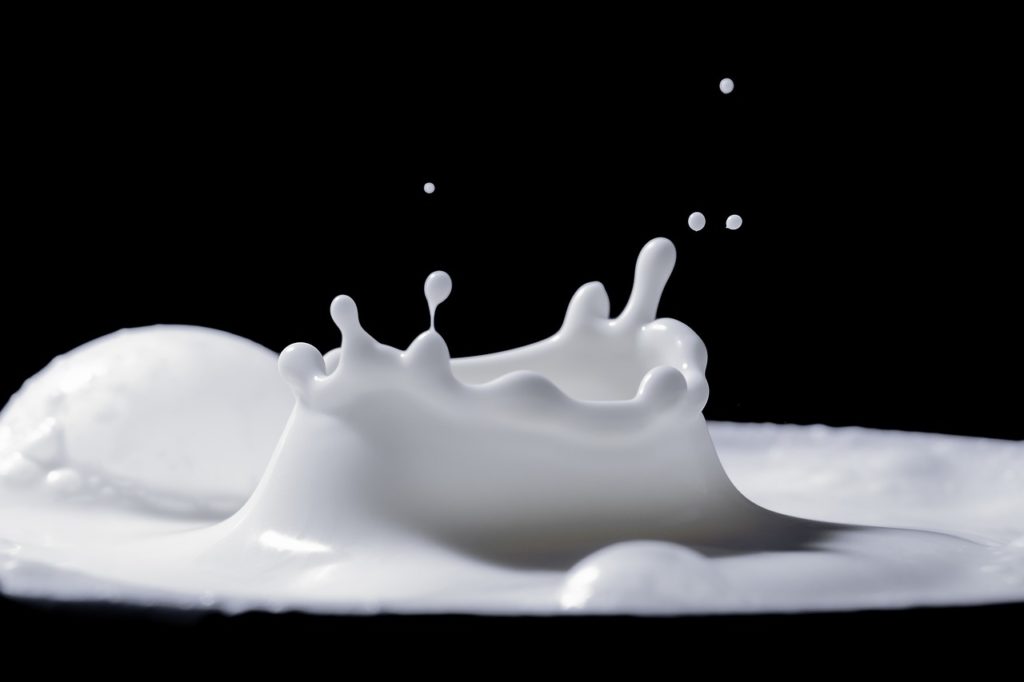
We’ve built a solid case against cow milk, but could the problem lie elsewhere? Maybe the issue isn’t cow milk but the farming methods used.
Earlier in the guide, we mentioned that dairy cows are kept pregnant for up to 290 days each year.
We also discussed that their milk becomes increasingly loaded with female hormones with each pregnancy.
In other words, drinking milk from cows that spend less of their adult life pregnant might not have the same effects on hormone levels.
In fact, drinking the right milk could supply your body with much-needed nutrients that promote good health, muscle gain, and post-exercise recovery.
In one study, researchers looked at fat-free milk consumption following resistance exercise.
The subjects (56 healthy young men) trained five days per week for twelve weeks and consumed fat-free milk, soy protein, or a carbohydrate drink immediately after training and one hour later.
Milk consumption led to the most significant muscle protein synthesis and overall hypertrophy for the study’s duration.
Another paper explored milk and soy-based proteins and their effects on protein synthesis and muscle gain in young and elderly individuals.
Milk proteins (casein and whey, in particular) are some of the highest-quality nutrients.
Their absorption is excellent, and the rate of digestion promotes a steady amino acid supply.
According to their data, as little as 8 to 10 grams of casein or whey can significantly stimulate muscle protein synthesis.
The final paper we’ll be looking at today was published in 2019 and looked at the data on dairy protein ingestion to prevent sarcopenia (age-related muscle loss).
According to their findings, older people should consume 0.4-0.6 g protein per kilogram per meal to improve muscle function and reduce the risk of lean tissue loss.
The review points out that dairy products provide high-quality protein and should be included in nutritional plans for older individuals at risk of muscle loss.
That’s if you tolerate dairy, that is. If not, eggs, poultry and meat contain high quality protein as well.
Milk And Testosterone Conclusion:
So, there we have it. Cow milk might seem unhealthy and harmful, but that’s not necessarily the case.
The farming methods used are far more critical for determining its impact.
One option to reduce the associated risks and still reap the benefits of milk consumption is to stick with low-fat milk (e.g., 1 percent).
You can also explore goat milk, which appears to have much less estrogen than cow milk.
